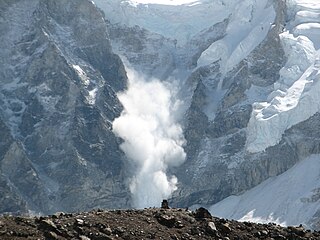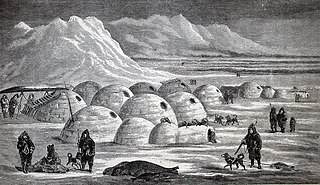
A glacier is a persistent body of dense ice that is constantly moving under its own weight. A glacier forms where the accumulation of snow exceeds its ablation over many years, often centuries. It acquires distinguishing features, such as crevasses and seracs, as it slowly flows and deforms under stresses induced by its weight. As it moves, it abrades rock and debris from its substrate to create landforms such as cirques, moraines, or fjords. Although a glacier may flow into a body of water, it forms only on land and is distinct from the much thinner sea ice and lake ice that form on the surface of bodies of water.

Ice is water frozen into a solid state, typically forming at or below temperatures of 32 °F, 0 °C, or 273 K. Depending on the presence of impurities such as particles of soil or bubbles of air, it can appear transparent or a more or less opaque bluish-white color.

Snow comprises individual ice crystals that grow while suspended in the atmosphere—usually within clouds—and then fall, accumulating on the ground where they undergo further changes. It consists of frozen crystalline water throughout its life cycle, starting when, under suitable conditions, the ice crystals form in the atmosphere, increase to millimeter size, precipitate and accumulate on surfaces, then metamorphose in place, and ultimately melt, slide or sublimate away.

An avalanche is a rapid flow of snow down a slope, such as a hill or mountain.

Cirrocumulus is one of the three main genus types of high-altitude tropospheric clouds, the other two being cirrus and cirrostratus. They usually occur at an altitude of 5 to 12 km. Like lower-altitude cumuliform and stratocumuliform clouds, cirrocumulus signifies convection. Unlike other high-altitude tropospheric clouds like cirrus and cirrostratus, cirrocumulus includes a small amount of liquid water droplets, although these are in a supercooled state. Ice crystals are the predominant component, and typically, the ice crystals cause the supercooled water drops in the cloud to rapidly freeze, transforming the cirrocumulus into cirrostratus. This process can also produce precipitation in the form of a virga consisting of ice or snow. Thus, cirrocumulus clouds are usually short-lived. They usually only form as part of a short-lived transitional phase within an area of cirrus clouds and can also form briefly as a result of the breaking up of part of a cumulonimbus anvil.

An igloo, also known as a snow house or snow hut, is a type of shelter built of suitable snow.
Limit State Design (LSD), also known as Load And Resistance Factor Design (LRFD), refers to a design method used in structural engineering. A limit state is a condition of a structure beyond which it no longer fulfills the relevant design criteria. The condition may refer to a degree of loading or other actions on the structure, while the criteria refer to structural integrity, fitness for use, durability or other design requirements. A structure designed by LSD is proportioned to sustain all actions likely to occur during its design life, and to remain fit for use, with an appropriate level of reliability for each limit state. Building codes based on LSD implicitly define the appropriate levels of reliability by their prescriptions.

In the Quechuan languages of South America, a huaca or wak'a is an object that represents something revered, typically a monument of some kind. The term huaca can refer to natural locations, such as immense rocks. Some huacas have been associated with veneration and ritual. The Quechua people traditionally believed every object has a physical presence and two camaquen (spirits), one to create it and another to animate it. They would invoke its spirits for the object to function.

Building material is material used for construction. Many naturally occurring substances, such as clay, rocks, sand, wood, and even twigs and leaves, have been used to construct buildings. Apart from naturally occurring materials, many man-made products are in use, some more and some less synthetic. The manufacturing of building materials is an established industry in many countries and the use of these materials is typically segmented into specific specialty trades, such as carpentry, insulation, plumbing, and roofing work. They provide the make-up of habitats and structures including homes.

Eismitte, in English also called Mid-Ice, was the site of an Arctic expedition in the interior of Greenland that took place from July 1930 through August 1931, and claimed the life of noted German scientist Alfred Wegener.

In physics, backscatter is the reflection of waves, particles, or signals back to the direction from which they came. It is usually a diffuse reflection due to scattering, as opposed to specular reflection as from a mirror, although specular backscattering can occur at normal incidence with a surface. Backscattering has important applications in astronomy, photography, and medical ultrasonography. The opposite effect is forward scatter, e.g. when a translucent material like a cloud diffuses sunlight, giving soft light.

An ice house, or icehouse, is a building used to store ice throughout the year, commonly used prior to the invention of the refrigerator. Some were underground chambers, usually man-made, close to natural sources of winter ice such as freshwater lakes, but many were buildings with various types of insulation.

The physics of skiing refers to the analysis of the forces acting on a person while skiing.

Chionoecetes is a genus of crabs that live in the northern Pacific and Atlantic Oceans.

An ice hotel is a temporary hotel made up of snow and sculpted blocks of ice. Ice hotels, dependent on sub-freezing temperatures, are constructed from ice and snow and typically have to be rebuilt every year. Ice hotels exist in several countries, and they have varying construction styles, services and amenities, the latter of which may include ice bars, restaurants, chapels, saunas and hot tubs.

Firn is partially compacted névé, a type of snow that has been left over from past seasons and has been recrystallized into a substance denser than névé. It is ice that is at an intermediate stage between snow and glacial ice. Firn has the appearance of wet sugar, but has a hardness that makes it extremely resistant to shovelling. Its density generally ranges from 0.35 g/cm3 to 0.9 g/cm3, and it can often be found underneath the snow that accumulates at the head of a glacier.

An ice road or ice bridge is a human-made structure that runs on a frozen water surface. Ice roads are typically part of a winter road, but they can also be simple stand-alone structures, connecting two shorelines. Ice roads may be planned, built and maintained so as to remain safe and effective, and a number of guidelines have been published with information in these regards. An ice road may be constructed year after year, for instance to service community needs during the winter. It could also be for a single year or two, so as to supply particular operations, such as a hydroelectric project or offshore drill sites.

Ablation zone or ablation area refers to the low-altitude area of a glacier or ice sheet below firn with a net loss in ice mass due to melting, sublimation, evaporation, ice calving, aeolian processes like blowing snow, avalanche, and any other ablation. The equilibrium line altitude (ELA) or snow line separates the ablation zone from the higher-altitude accumulation zone. The ablation zone often contains meltwater features such as supraglacial lakes, englacial streams, and subglacial lakes. Sediments dropped in the ablation zone forming small mounds or hillocks are called kames. Kame and kettle hole topography is useful in identifying an ablation zone of a glacier. The seasonally melting glacier deposits much sediment at its fringes in the ablation area. Ablation constitutes a key part of the glacier mass balance.

Palsas are peat mounds with a permanently frozen peat and mineral soil core. They are a typical phenomenon in the polar and subpolar zone of discontinuous permafrost. One of their characteristics is having steep slopes that rises above the mire surface. This leads to the accumulation of large amounts of snow around them. The summits of the palsas are free of snow even in winter, because the wind carries the snow and deposits on the slopes and elsewhere on the flat mire surface. Palsas can be up to 150 m in diameter and can reach a height of 12 m.
A natural hazard is a natural phenomenon that might have a negative effect on humans and other animals, or the environment. Natural hazard events can be classified into two broad categories: geophysical and biological.


















